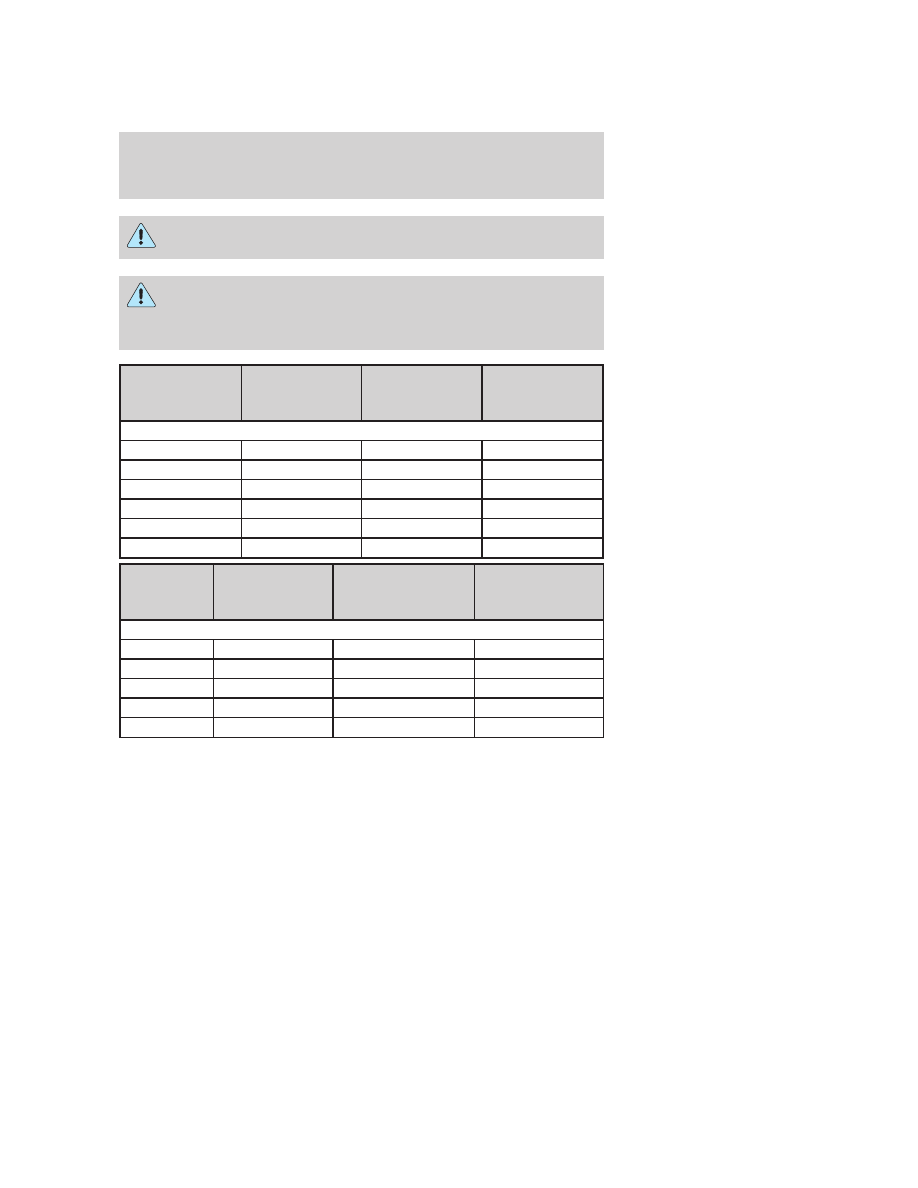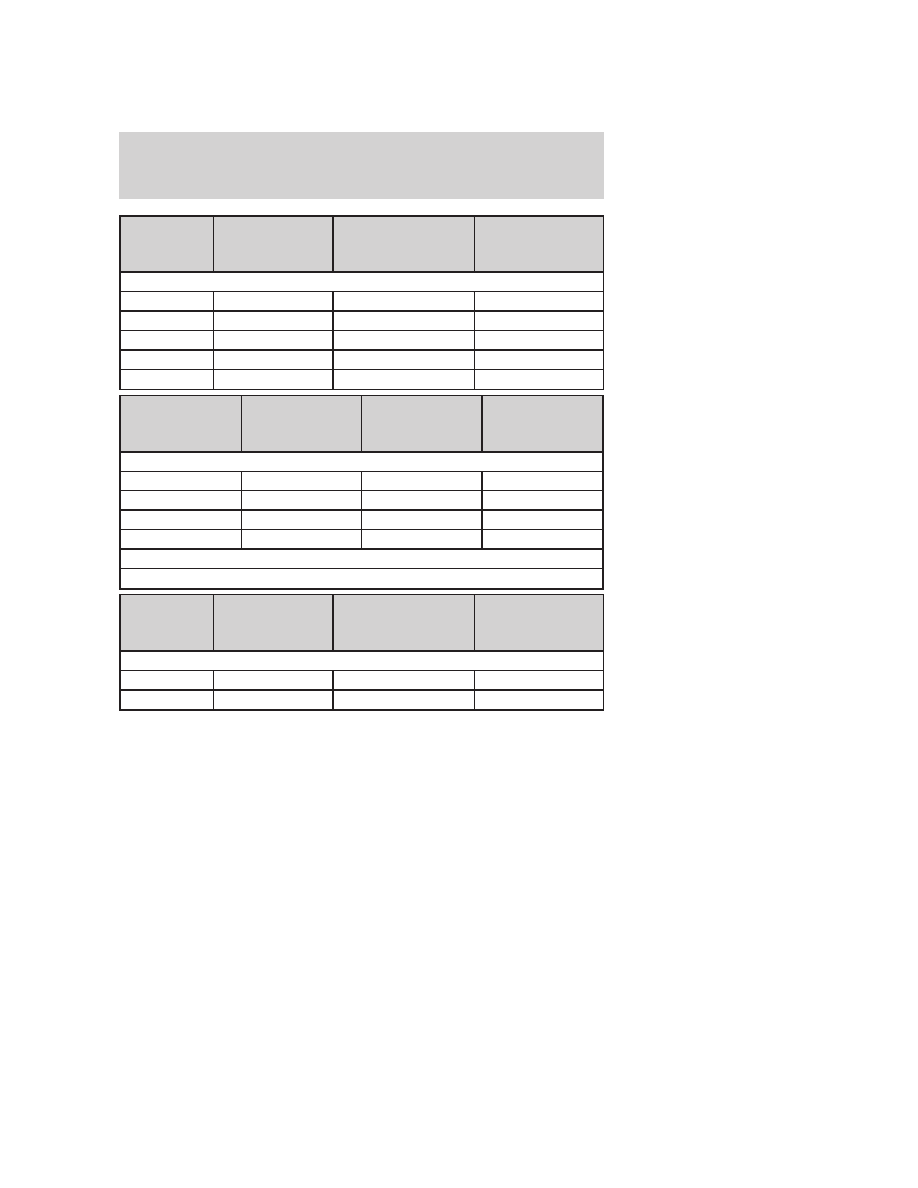Ford F-150 Heritage (2004 year). Manual — part 33

Do not exceed the GVWR or the GAWR specified on the
certification label.
Towing trailers beyond the maximum recommended gross trailer
weight exceeds the limit of the vehicle and could result in
engine damage, transmission damage, structural damage, loss of vehicle
control, vehicle rollover and personal injury.
Engine
Rear axle ratio Maximum
GCWR - lbs.
(kg)
Maximum
trailer weight -
lbs. (kg)
Regular Cab 4x2 w/automatic transmission
4.2L
3.31
9000 (4077)
4600 (2087)
4.2L
3.55
10000 (4536)
5700 (2585)
4.6L
3.08
10000 (4536)
2000 (907)
4.6L
3.31
10500 (4763)
6100 (2767)
4.6L
3.55
11500 (5216)
7100 (3221)
5.4L
3.73
13500 (6123)
8400 (3810)
Engine
Rear axle ratio
Maximum GCWR
- lbs. (kg)
Maximum
trailer weight -
lbs (kg)
Regular Cab 4x2 w/manual transmission
4.2L
3.08
6500 (2944)
2000 (907)
4.2L
3.55
7800 (3538)
3500 (1588)
4.6L
3.08
6500 (2944)
2000 (907)
4.6L
3.31
7200 (3266)
2900 (1315)
4.6L
3.55
7800 (3538)
3500 (1588)
Driving
134

Engine
Rear axle ratio
Maximum
GCWR - lbs.
(kg)
Maximum
trailer weight -
lbs. (kg)
Regular Cab 4x4 w/automatic transmission
4.2L
3.55
10000 (4536)
5400 (2449)
4.6L
3.31
10500 (4763)
5800 (2631)
4.6L
1
3.55
11500 (5216)
6800 (3084)
4.6L
2
3.55
11000 (4990)
6300 (2858)
5.4L
3.73
13500 (6123)
8000 (3629)
1
16” tires
2
17” tires
Engine
Rear axle ratio Maximum GCWR
- lbs. (kg)
Maximum
trailer weight -
lbs. (kg)
Regular Cab 4x4 w/manual transmission
4.2L
3.31
7200 (3265)
2500 (1134)
4.2L
3.55
7800 (3538)
3200 (1452)
4.6L
3.31
7200 (3265)
2500 (1134)
4.6L
3.55
7800 (3538)
3100 (1406)
Engine
Rear axle ratio Maximum
GCWR - lbs.
(kg)
Maximum
trailer weight -
lbs. (kg)
SuperCab 4x2 w/automatic transmission
4.2L
3.31
9000 (4077)
4500 (2041)
4.2L
3.55
10000 (4536)
5500 (2495)
4.6L
3.08
10000 (4536)
2000 (907)
4.6L
3.31
10500 (4763)
5900 (2676)
4.6L
3.55
11500 (5216)
6900 (3130)
5.4L
3.73
13500 (6123)
8200 (3719)
Driving
135

Engine
Rear axle ratio
Maximum GCWR
- lbs. (kg)
Maximum
trailer weight -
lbs. (kg)
SuperCab 4x2 w/manual transmission
4.2L
3.08
6500 (2944)
2000 (907)
4.2L
3.55
7800 (3538)
3300 (1497)
4.6L
3.08
6500 (2944)
2000 (907)
4.6L
3.31
7200 (3266)
2600 (1179)
4.6L
3.55
7800 (3538)
3200 (1451)
Engine
Rear axle ratio
Maximum
GCWR - lbs.
(kg)
Maximum
trailer weight -
lbs. (kg)
SuperCab 4x4 w/automatic transmission
4.6L
3.31
10500 (4763)
5500 (2495)
4.6L
1
3.55
11500 (5216)
6500 (2948)
4.6L
2
3.55
11000 (4990)
6000 (2722)
5.4L
3.73
13500 (6123)
7800 (3538)
1
16” tires
2
17” tires
Engine
Rear axle ratio
Maximum GCWR
- lbs. (kg)
Maximum
trailer weight -
lbs. (kg)
SuperCab 4x4 w/manual transmission
4.6L
3.31
7200 (3266)
2300 (1043)
4.6L
3.55
7800 (3538)
2900 (1315)
Trailer frontal area considerations:
• Not to exceed towing vehicle frontal area without Class III trailer
towing package
• Not to exceed 60 square feet (5.52 square meters) with Class III
trailer towing package
Preparing to tow
Use the proper equipment for towing a trailer and make sure it is
properly attached to your vehicle. See your dealer or a reliable trailer
dealer if you require assistance.
Driving
136

Hitches
Do not use hitches that clamp onto the vehicle’s bumper or attach to the
axle. You must distribute the load in your trailer so that 10%–15% of the
total weight of the trailer is on the tongue.
Load equalizing hitch
When hooking up a trailer using a load equalizing hitch, always use the
following procedure:
1. Park the unloaded vehicle on a level surface. With the ignition on and
all doors closed, allow the vehicle to stand for several minutes so that it
can level.
2. Measure the height of a reference point on the front and rear bumpers
at the center of the vehicle.
3. Attach the trailer to the vehicle and adjust the hitch equalizers so that
the front bumper height is within
1
⁄
2
” (13 mm) of the reference point.
After proper adjustment, the rear bumper should be no higher than in
Step 2.
Note: Adjusting an equalizing hitch so the rear bumper of the vehicle is
higher than it was unloaded will defeat the function of the load
equalizing hitch and may cause unpredictable handling.
Safety chains
Always connect the trailer’s safety chains to the frame or hook retainers
of the vehicle hitch. To connect the trailer’s safety chains, cross the
chains under the trailer tongue and allow slack for turning corners.
If you use a rental trailer, follow the instructions that the rental agency
gives to you.
Do not attach safety chains to the bumper.
Trailer brakes
Electric brakes and manual, automatic or surge-type trailer brakes are
safe if installed properly and adjusted to the manufacturer’s
specifications. The trailer brakes must meet local and Federal
regulations.
Do not connect a trailer’s hydraulic brake system directly to your
vehicle’s brake system. Your vehicle may not have enough
braking power and your chances of having a collision greatly increase.
Driving
137

Нет комментариевНе стесняйтесь поделиться с нами вашим ценным мнением.
Текст